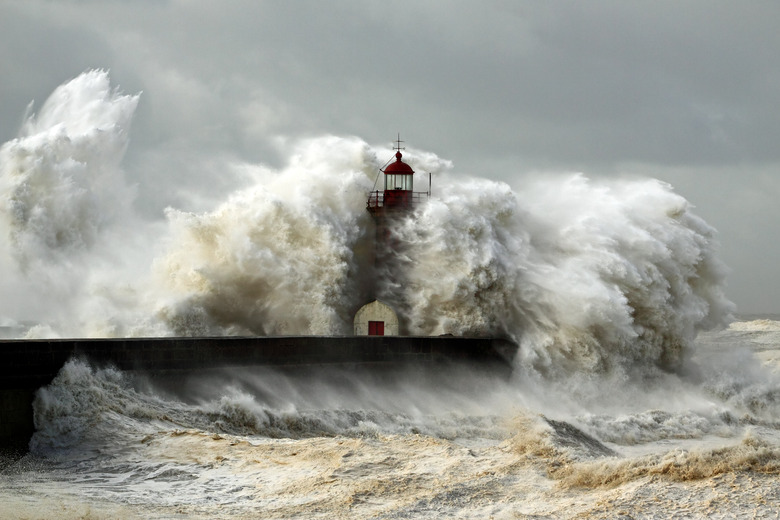Effects Of A Tsunami On The Marine Ecosystem
A tsunami is a wave, or series of waves, caused by the vertical displacement of a column of water. This can be generated by earthquakes below the sea floor and violent volcanic eruptions above it, landslides above or below water or meteorite impacts into the sea. Tsunamis scrape seafloor sediments and invertebrates, crash through coral reefs and destroy coastal vegetation. While ecosystems can recover, human interference may interfere.
Wave Generation and Propagation
Wave Generation and Propagation
The most destructive tsunamis are generated by the rupture of the Earth's crust below the sea floor during an earthquake. The crust beneath the Indian and Pacific ocean floors, for instance, consists of numerous collision boundaries between tectonic plates. The ocean floor can be thrust upwards, sideways or downward. In all cases, the movement displaces a massive amount of water that develops on the ocean surface like a small hump of less than a meter high but with a wavelength of hundreds of kilometers. This travels in all directions under its own momentum, reaching speeds of as much as 900 kilometers per hour in the deep ocean at water depths as much as 4.5 km (2.8 miles). Its speed decreases to between 35 and 40 kph (21.8 to 25 mph) when it reaches 10 meter (39 feet) water depths close to shore, though its height can reach nearly 10 meters. However, its height can grow to more than 30 meters (100 feet) if the wave is confined within a bay or natural harbor.
Sea Floor Erosion
Sea Floor Erosion
The base of a tsunami wave can change the topography of the sea floor. It erodes seafloor sediments and can devastate the benthic – sea bottom – ecosystems on the sea floor. These are usually invertebrates like crustaceans, worms and snails that burrow through sea floor sediments and mix them. Sometimes, huge chunks of the sea floor can ripped up. The March 2011 Tohoku, Japan, earthquake tsunami deposited the eroded sediments in other locations as huge seafloor sand dunes.
Coral Reefs
Coral Reefs
Coral reefs are natural breakwaters for a tsunami wave as it moves towards the coastline. The December 2004 Indonesian earthquake tsunami devastated coral reefs around Indian Ocean coastlines. Later investigations showed that the reefs were already dying because fishermen had exploded dynamite or poured cyanide compounds into the sea to catch fish. Four years after the tsunami, the healthy corals were regenerating.
Intertidal Environments
Intertidal Environments
Seagrass beds, mangrove forests, coastal wetlands and their associated fish and animal life in the intertidal zone are particularly vulnerable to tsunamis. This is the part of a coast that is exposed to the air at low tide and is submerged at high tide. Prior to the 2011 tsunami, underwater sea grass along northern Japan's Sendai coast had grown to the height of a two-story building. Masahiro Nakaoka, a marine ecologist at Hokkaido University observed new sea-grass shoots growing two years after the tsunami and estimated they needed a decade to revive. However, the construction of new seawalls and breakwaters as man-made tsunami barriers may hinder this revival. The barriers would cut off water nutrient-rich water courses that flow from the mountains onshore and into the sea.
Species Invasion
Species Invasion
Tsunamis can carry massive amounts of debris from one side of the ocean to another. A concrete block from Misawa, Japan took 15 months to cross the Pacific Ocean and crash into the Oregon coast. Algae and other organisms attached to this debris survived the ocean crossing. These can establish new communities in Oregon and potentially displace native species.
References
- National Museum Northern Ireland: A Tsunami Sweeps across an Ancient Sea Floor at Larne, Northern Ireland
- Japan Daily Press: Giant Underwater Dunes Created by March 2011 Tsunami
- Wildlife Extra: Asian Coral Reefs Recovering Strongly 4 Years after the Tsunami
- Japan Times: Tohoku Coast Faces Man-Made Perils in Wake of Tsunami
- Nature: Tsunami Triggers Invasion Concerns
- PLOS ONE: Disturbance of Shallow Marine Soft Bottom Environments and Megabenthos Assemblages by a Huge Tsunami Induced by the 2011 M9.0 Tohoku-Oki Earthquake
Cite This Article
MLA
Kielmas, Maria. "Effects Of A Tsunami On The Marine Ecosystem" sciencing.com, https://www.sciencing.com/effects-tsunami-marine-ecosystem-7188/. 13 March 2018.
APA
Kielmas, Maria. (2018, March 13). Effects Of A Tsunami On The Marine Ecosystem. sciencing.com. Retrieved from https://www.sciencing.com/effects-tsunami-marine-ecosystem-7188/
Chicago
Kielmas, Maria. Effects Of A Tsunami On The Marine Ecosystem last modified August 30, 2022. https://www.sciencing.com/effects-tsunami-marine-ecosystem-7188/
